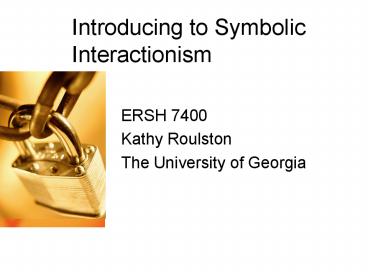Introducing to Symbolic Interactionism - PowerPoint PPT Presentation
1 / 17
Title:
Introducing to Symbolic Interactionism
Description:
Introducing to Symbolic Interactionism ERSH 7400 Kathy Roulston The University of Georgia Disciplinary roots American pragmatism Social psychology Symbolic ... – PowerPoint PPT presentation
Number of Views:699
Avg rating:3.0/5.0
Title: Introducing to Symbolic Interactionism
1
Introducing to Symbolic Interactionism
- ERSH 7400
- Kathy Roulston
- The University of Georgia
2
Disciplinary roots
- American pragmatism
- Social psychology
- Symbolic interactionism
- explores the understandings abroad in culture as
the meaningful matrix that guides our lives
(Crotty, 1998, p.71)
3
Symbolic interactionism
- A distinctive style of sociological reasoning and
methodology that has evolved in and about the
Department of Sociology at the University of
Chicago in the 1920s 1930s - Research
- Tentative
- Empirical
- Responsive to meaning
4
- Howard Becker its not an easy position to
understandpartly, I think, because (like Zen)
its so simple. - Herbert Blumer The symbolic interactionist
approach rests upon the premise that human action
takes place always in a situation that confronts
the actor and that the actor acts on the basis of
defining this situation that confronts him.
5
Scholars
- Herbert Mead (1863-1931) social psychologist
- Herbert Blumer (1900-1986)
- (Mead student)
- Erving Goffman
- Chicago School
- Howard Becker
- Glaser Strauss
6
Central premises (Blumer)
- Humans act toward things on the basis of meanings
these things have for them - Meaning of such things is derived from social
interactions of one with others - Meanings are handled/ modified through an
interpretive process used by one in dealing with
things he/she encounters
7
Assumptions
- People are unique creatures because of their
ability to use symbols - People become distinctively human through their
interaction - People are conscious and self-reflexive beings
who actively shape their own behavior - People are purposive creatures who act in and
toward situations.
8
Assumptions
- Human society consists of people engaging in
symbolic interaction - To understand peoples social acts, we need to
use methods that enable us to discern the
meanings they attribute to these acts (Sandstrom,
Martin, Fine, 2001)
9
- A person is a personality because he belongs to a
community, because he takes over the institution
of that community into his own conduct - The whole (society) is prior to the part (the
individual). - (George Herbert Mead)
10
Focus
- Study the functional relationship between how we
see ourselves (self-definition), how we see
others (interpersonal perceptions) and how we
think others see us. - To understand social reality and society from the
perspective of the actors who interpret their
world through and in social interaction. - To explain the set of understandings symbols
that give meaning to peoples interactions.
11
What was new?
- Broke away from traditional efforts to construct
mock-scientific theory and method to observe
social life as it occurs, observe people as they
go about their affairs. - Aimed to provide fuller depictions of actual
conducts in real circumstances. - Critique of quantitative methods as inappropriate
to capture the nature of social life.
12
Methodologies
- Ethnography
- Grounded theory (Glaser Strauss)
13
Methods
- Participant and non participant observation
- Interviews
14
Field work
- Not to be reduced to a strict method or recipe
- Role of field researcher loosely defined and open
ended - Research as exploratory
- View sympathetic to those under study
- Tradition of urban anthropologies
- Occupational studies
15
Central questions
- What common set of symbols and understandings
have emerged to give meaning to peoples
interactions? - Contributions
- Self identity theory
- Emotions
- Social coordination
- Social construction (e.g. Deviance social
problems) - Culture art
- Organizations collective action
16
Future directions
- Incorporation of perspectives from
- Feminist theory
- Critical theory
- Postmodern theory
17
Critiques
- We cant see through others eyes.
- Actors put forward what they wish (e.g. tell
you what you want to hear) - Has neglected topics such as social structures,
institutions, power ideology































